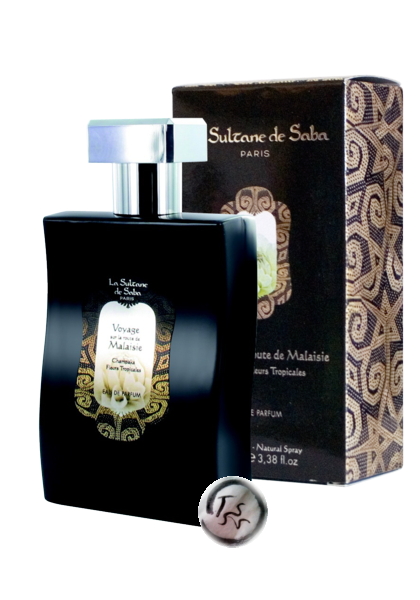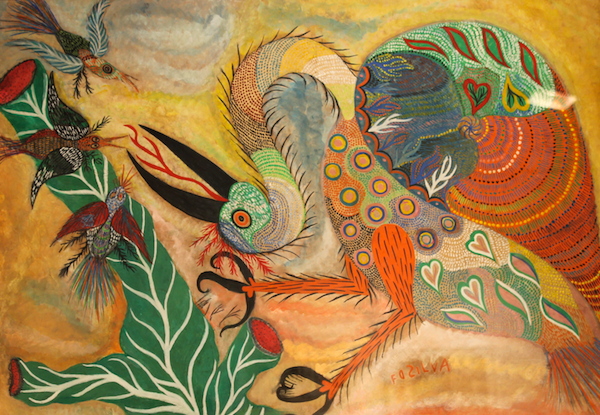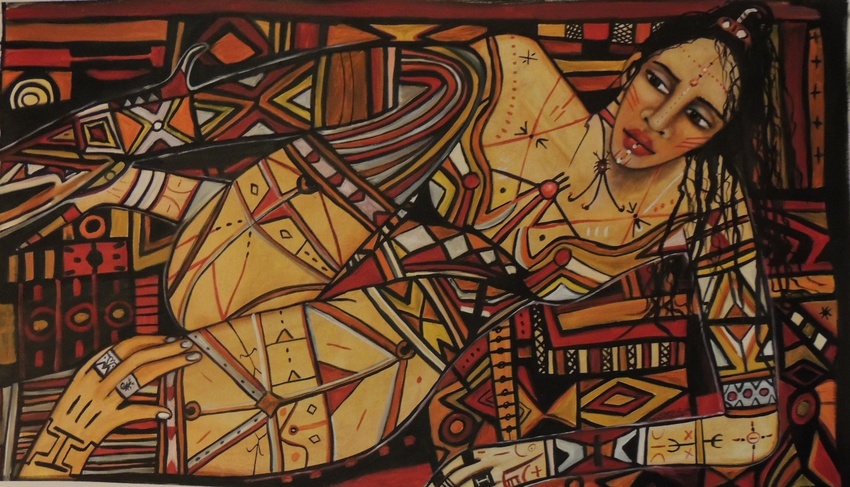La Sultane de Saba Champaka Fleurs Tropicales - An Outsider Art Creation (2014) {Perfume Review & Musings}
 I've come to think that French spa house La Sultane de Saba founded by Vanessa Sitbon might be one of the few and staunchest defensers of well-saturated perfumes, just like you can speak of a color which is well-saturated or not. Watercolors - at the opposite end of the spectrum - are not their jam...
I've come to think that French spa house La Sultane de Saba founded by Vanessa Sitbon might be one of the few and staunchest defensers of well-saturated perfumes, just like you can speak of a color which is well-saturated or not. Watercolors - at the opposite end of the spectrum - are not their jam...
It's not Fauvism, it's not Orphism, it's not Primitivism - to me, it feels more like Outsider Art.
But let's track back a little if you will.
When you are used to natural tinctures in the color world, synthetic shades feel like everything that could be said about their related synthetic aromatic molecules: they are too glaring and do not have enough nuances. Yet, some people have an innate appreciation of this well-modulated sense of excess.
Perfumer Guy Robert in his book Les sens du parfum uses the term "violent" as a technical perfumery term to describe fragrances which have an extra olfactory punch. Champaka Fleurs Tropicales, inspired by a travel-diary theme set in Malaysia is named after the fragrant Joy Perfume Tree (Magnolia champaca) native to the region and the composition is exactly in that lineage of over-the-top perfumes.
It evokes for you in the contemporary 21st century perfumery landscape what impression our ancestors might have had when they inhaled for the first time a fragrance in the beginning of the 20th century made with an oversupply of synthetics.
When pioneer fragrance industrialist and nose François Coty felt a pull towards those odors bottling them at the beginning of the 20th century, they were perceived as being too "violent," yet as some found out, interesting all the same.
At a time when the balance between naturals and synthetics might not have been so well thought out yet, with no predetermined code or tradition to fall back upon - and people like Coty were still searching - moderation was apparently not a virtue. If you are excited about something new, you might become almost trigger-happy about it - and this is what you can assume might have happened for a little while with those new "violent" odors with incredible potential.
 By contrast, you can have cheap fragrances that will come across as both unbalanced and vociferous. Not so with Champaka. It is "violent" in an authentic manner, bespeaking of style consistency rather than awkwardness. Because it seems to reflect the temperament of artistic director Vanessa Sitbon who is said to have a heavy hand in the designs of her fragrances, and because it manages in the end to convince you with its bold impact instead of coming across as a rude perfume.
By contrast, you can have cheap fragrances that will come across as both unbalanced and vociferous. Not so with Champaka. It is "violent" in an authentic manner, bespeaking of style consistency rather than awkwardness. Because it seems to reflect the temperament of artistic director Vanessa Sitbon who is said to have a heavy hand in the designs of her fragrances, and because it manages in the end to convince you with its bold impact instead of coming across as a rude perfume.
I first came across La Sultane de Saba several years ago at the Galeries Lafayette, I believe, where they had a counter stocked up with bath products inspired by Moroccan tradition, the primary source of inspiration for Sitbon.
Banned from Heaven by Marianna McCarthy
More recently, I happened on a vivid bottle of L'Elixir de la Mariée, a beauty yet sensory product for the eyes and nose too. Its outside-of-the-trends personality struck me {review upcoming} and also reminded me faithfully of a much rarer composition which was recreated by perfumer Francis Kurkdjian for the Château de Versailles and once said to be a scent beloved by Marie-Antoinette, M.A. Sillage de la Reine. L'Elixir de la Mariée smells both ancient and intense.
This intriguing stylistic choice led me to pay closer attention to the rest of the products of the house, which, as it happens, launched two perfumes this year, the one I'm reviewing today and another one called Ambre, Musc, Santal, which I would also like to review.
To take another point of comparison, you can turn to the 1980s and the fragrance Giorgio in particular which we all remember and which in that era was a new symbol of olfactory overdose and daring. Well, Champaka is different from the type of olfactory big-presence Giorgio delivers, still echoing in the chambers of our noses.
Champaka is in fact more uncompromising. It behaves more like a soliflore, but with original, secondary nuances playing out a little spicy music to underscore the main floral accord. The musks, which are "white" but certainly not shy nor transparent are used in such a way as to be like a spice additive. It's intense, salty and unusually paired with indoles and the natural muskiness of flowers, which seem to be sweating quite profusely in the heat.
According to the olfactory pyramid, the musk is featured in the heart, while the base is 100% floral with jasmine, freesia, tuberose and rose of May. The tuberose does linger on on the skin towards the very end as one of the last recognizable notes.
More to the point, what is felt with these descriptive poetic licenses where you would expect the musk to be in the base and the floral notes to be in the heart is that Champaka conveys a sense of originality in the sense, I am almost tempted to say, of "raw originality," one which is not formatted nor playing with academic codes. The perfume is original more in the style of self-taught outsider art. It's unique, it's convincing, it's what it is.
If you want to discover a perfume which, at one level, is a lush white tropical floral perfume, and at another level, a fragrance with a pretty unique signature, you should definitely give it a try.
Fragrance notes: ylang, petit grain, violet / champaka of Borneo, orange blossom, vanilla, white musks / jasmine, freesia, tuberose, Rose of May.










